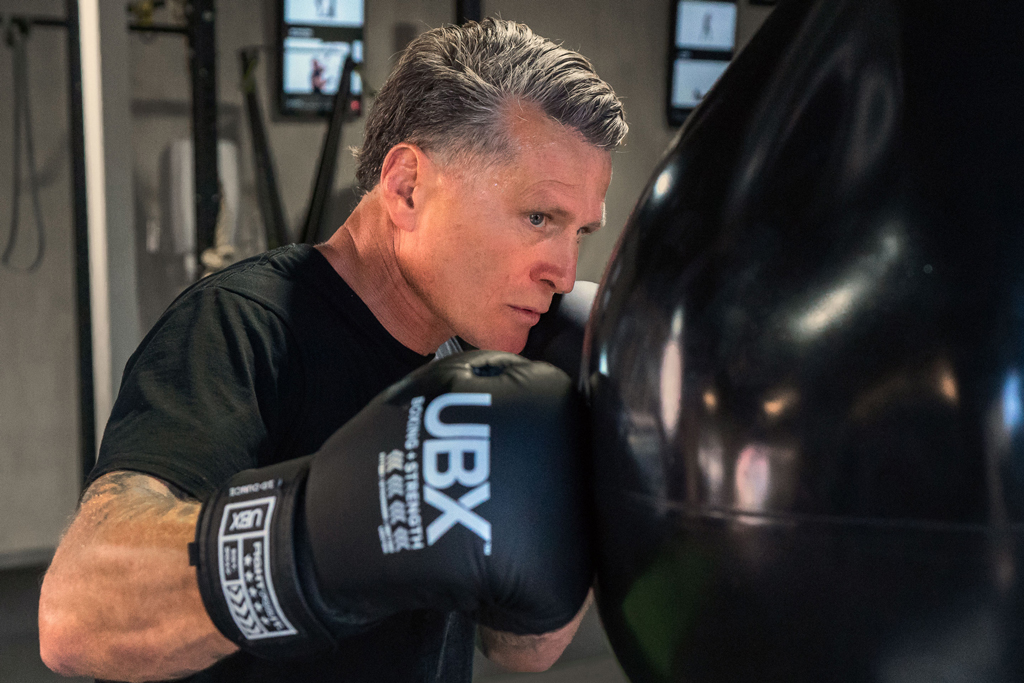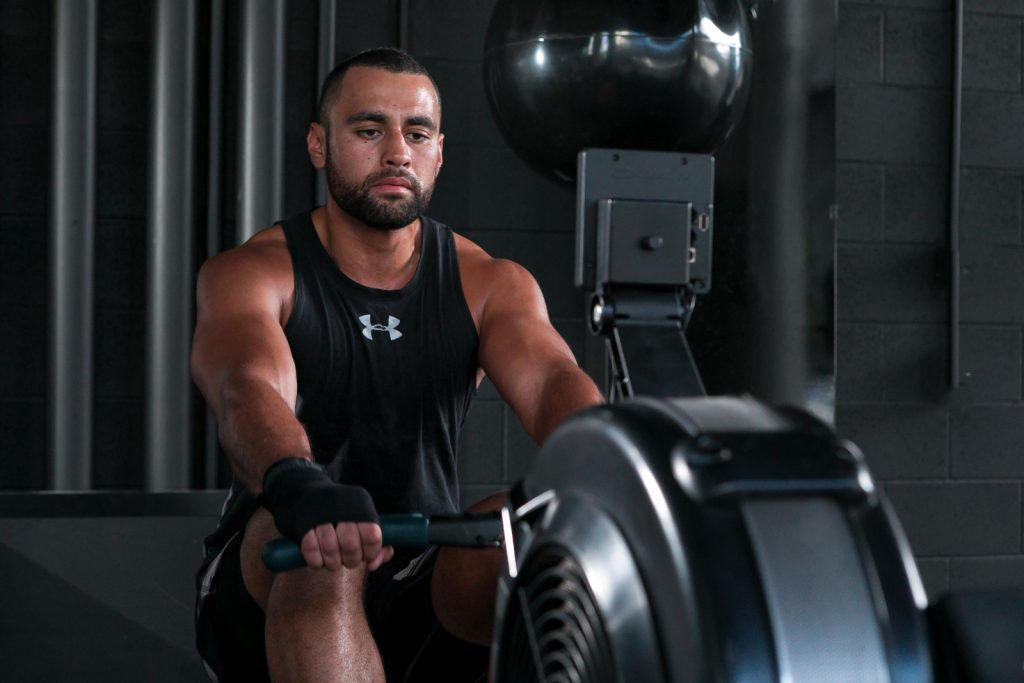In boxing, fighters may adopt varying punching styles but every single boxer starts with the same basic foundations for maximising power and speed, and maintaining the correct technique to increase efficiency of movement and reduce risk of injury.
If you’re new to boxing, watch this video with our Head of Boxing and four-time world champion boxer, Danny Green for a complete beginner’s intro.
It starts with your feet
Contrary to what you might think, throwing a punch actually starts with your foot placement, also known as “stance”.
Your boxing stance is the “base” of everything that you do and keeps you balanced and firmly planted while you create the momentum to throw a punch. The right technique can make all the difference in your accuracy, how you generate power and speed, and how agile you are through each movement.
Simple steps for boxing stance:
- Imagine a square on the floor and put your feet in opposite corners of the front and back of that square. The foot that goes forward is the opposite to your usual dominant hand, whilst the other goes back.
- If you’re usually right-handed, you would put your left foot forward – this stance is called “Orthodox”
- If you’re usually left-handed, you would put your right foot forward – this stance is called “Southpaw”
- Keep your knees slightly bent and flexed to ensure you have a little bit of bounce to your step, and keep your back heel up slightly so that the weight is mostly in the ball of your foot.
Stance can also vary depending on your personal boxing style, and finding the right stance takes patience – practise makes perfect!
Keeping your guard up
When you’re throwing a punch, your other fist should always be up in “Guard” – not only is this important for protecting your face and body when you’re exposed during a punch, it also sets up your arm for a counter-punch.
How your boxing guard should look:
Whichever side has a foot forward (your Lead Foot) is the side of your “Lead Hand”, whilst the other is your “Rear Hand”. When your hands are up in “Guard” your lead hand is placed in front, hovering between your eye and your chin, whilst your rear hand is close to your ear and chin, like it’s holding a telephone.
Whenever you throw a punch, always remember to keep the alternating hand firmly in guard until your fist returns.
It’s all about mastering the basics
There are 5 primary punches used in boxing:
- Jab
- Cross
- Hook
- Uppercut
- Rip
Each punch serves a different purpose in a fight and requires a different technique across the entire body with how you implement footwork through to the overall execution of impact into your fist.
How to throw a Jab:
The Jab is one of the most important punches in a boxer’s repertoire for building range, establishing position and setting up power shots.
- Your stance is crucial – stay balanced and keep your weight evenly distributed
- Generate momentum and speed by shifting your weight
- Let the motion travel from your back foot, through your hips and into your punch
- Extend the punch – keep your elbow tucked, your wrist square and fist straight
- Snap back – remember to bring your hand straight back into your guard
The Jab should be considered your go-to punch. Whether you’re sparring with a partner or on a boxing bag, the Jab is a great way to maintain and create distance between you and your target, and to set up a combination.
How to throw a Cross:
The Cross is a very powerful punch, and is known to be an effective knockout blow. Many of our combinations end with a cross, utilising the punches immediately before it to set yourself up in a way that maximises power.
- Keep your arm straight and throw the cross in a straight line from your initial starting point, towards your target
- Maintain a steady base and generate power from your feet, exploding forward and shifting your weight through
- Let the motion travel from your back foot, through your hips and into your punch, twisting to achieve a full extension
- “Turn the punch over” by keeping your wrist square and creating impact and connection with your first two knuckles
- Snap back – remember to bring your hand straight back into your guard
How to throw a Hook:
The Hook is a punch that’s thrown across your body in a curved motion, starting with your elbow bent at a right-angle and punched out and into your opponent, following through with your body, using your core and shifting the weight on your heels to create power.
This punch can be thrown either as a “Lead Hook” or a “Rear Hook” and is a powerful close-range attack typically used to target your opponent’s head or body.
A Hook is one of those punches that can vary in “style” depending on the fighter, and might also adapt depending on where your target is in relation to your position.
How to throw an Uppercut:
The Uppercut, as the name suggests, is where you throw your punch in an upward blow. This is often a trickier punch for beginners and takes time to master. Usually used during close range, and sometimes mid-distance, when you’re facing an opponent, the aim is to cut through their guard and land the punch on the lower point of their chin.
How to throw a Rip:
A Rip is predominantly used as a counterpunch thrown after an evasion. Think of it as an in-between of a hook and an uppercut – designed to be punched at an angle, across the body and in an upwards motion. Sometimes known as a “Body Hook”, rips are designed to target the torso, and require you to change levels slightly, using a bend in your knees and twist of your torso to explode upwards and into the punch.
Common mistakes amongst beginner boxers
Fist formation
- First you want to make sure that you DO NOT tuck your thumb into your fist, and instead start with an open hand, bending down your fingers and resting your thumb on top. If your thumb was enclosed under your fingers, you could risk breaking your thumb upon impact.
Lack of Balance
- Once you begin boxing – whether with a coach, sparring partner or against a boxing bag – and begin moving around, when you’re new to the movement your stance can start to shift.
- If you begin to get too narrow in your foot placement, you can easily lose balance. Similarly, if your feet aren’t planted correctly and you shift your weight too far forward or back, you can also fall into your punch.
- Meanwhile, if your stance is too wide, you may fail to generate enough momentum and power behind your punch.
- When you’re starting out, take a moment after every few punches or combinations to reset your stance until it becomes second nature.
Bending at the Wrist
- It’s important to always keep your fist square to your wrist. If you land a punch and your fist is angled slightly up or down, firstly you may miss your mark and second the impact on your joint can cause injury or strain to your wrist.
- This can be helped by ensuring that you use the correct hand-wrapping techniques and wear a suitable glove for your format of boxing (read more here)
Punching at the incorrect angle
- You should always aim to land your punches by making contact with the knuckles on your pointer finger and middle finger – this also ensures that your punch lands with a square wrist, and against the flattest part of your fist. Similar to wrist placement above, this also minimises risk of injury or strain, and maximises the impact of your punch
The beauty of boxing is that you can start with the basics and continue developing the skill long-term because there’s no limit to your progression.
At UBX, we have trained coaches who can work with you on basic boxing stance and technique, and help you improve over time at your pace. Our coaches will also ensure that you can modify workouts to suit your current level of fitness and identify ways to encourage your strength progression. It’s a great way to get started, especially if you want to enjoy the skill development of boxing without having to fight or spar other members.
Let’s get the gloves on and see what’s possible







